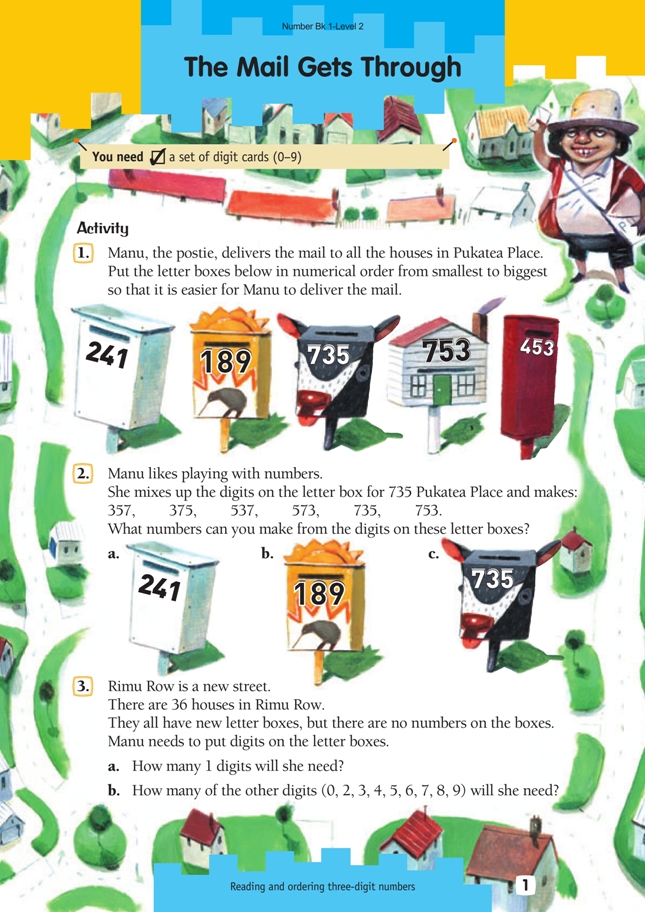This is a level 2 number activity from the Figure It Out series. It relates to Stage 5 of the Number Framework.
A PDF of the student activity is included.
Click on the image to enlarge it. Click again to close. Download PDF (338 KB)
read 3 digit numbers
order 3 digit numbers
FIO, Level 2, Number, Book 1, The Mail Gets Through, page 1
This activity focuses on ordering numbers from 0 to 1 000. To do this activity, students need to be able to recognise the numbers in this range.
Model for the students by reading the numbers aloud in their full form, that is, “two hundred and forty-one”. This makes the place value of the digits very clear. If you say “two forty-one” or “two four one”, some or all of the digits are treated inappropriately as only representing the ones place value.
After the students have done question 1, ask them how they know that they have ordered the numbers from smallest to biggest. The students are likely to explain that 189 is smallest because it has only one hundred, 241 has two hundreds, and so on. When comparing 735 and 753, the students will have to go beyond the hundreds and decide which has more tens.
You could ask the students what the letter box numbers have in common, that is, they are all odd numbers, and they all have three digits. This might lead to a discussion of how streets are laid out, with even numbers on one side of the street and odd numbers on the other.
You could extend the problem by asking the students to list three letter box numbers that would be between each pair of the ordered letter box numbers.
For question 2, the students can use the digit cards to make the different three-digit combinations. To avoid repeating numbers, they should record each three-digit number as they make it.
When the students have completed this question, you could ask them, “How do you know you’ve made all the three-digit numbers you can using those three digits?” Some students may have taken a methodical approach to solving these questions, following the model given, that is, each of the three digits appears twice in the hundreds place, with the two other digits used interchangeably in the tens and ones places.
You can easily extend these problems by introducing a fourth digit to make four-digit numbers. Students who have found these questions easy may like to go on to do On the Cards in Number, Figure It Out, Levels 2–3, page 7.
Ask the students to estimate the answers to question 3 before actually working them out. To solve the problems here, the students could list the numbers from 1 to 36 and count the number of times each digit occurs. Alternatively, they could refer to a hundreds board. In both cases, they could use tally marks next to a list of the digits 0 to 9.
To extend the students’ recording into an organised table, you could model making a table, with the digits 0 to 9 along the top and four rows, as shown below. Under each digit, the students need to write the number of times that digit is used in the range of numbers that is given in the cell at the left of each row.
Answers to Activity
1. 189, 241, 453, 735, 753
2. a. 241, 214, 142, 124, 421, 412
b. 189, 198, 819, 891, 918, 981
c. 735, 753, 375, 357, 537, 573
3 .. a14
b. 14 twos
11 threes
4 fours, fives, and sixes
3 sevens, eights, nines, and zeros

